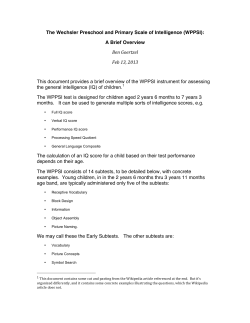
Intelligence Testing: Wechsler and Stanford-Binet Scales Wechsler Adult Intelligence Scale (WAIS)
Intelligence Testing: Wechsler and Stanford-Binet Scales PSYC 4503: Psych Tests and Evaluation Dr. Spiller Fall 2007 Wechsler Adult Intelligence Scale (WAIS) Tests made up of items that are appropriate for a wide range of ages Subject receives a certain # of points for each item answered correctly. 1939 – Wechsler-Bellevue Intelligence Scale – designed as adult-oriented point scale of intelligence 1955 – Wechsler Adult Intelligence Scale (WAIS) – most widely used individual test of adult intelligence Characteristics of the WAIS-III 14 separate subtests 11 subtests are used to compute a full-scale IQ score, a Verbal IQ score, and a Performance IQ score Also yields more specific indices (new to WAIS-III): Verbal Comprehension Perceptual Organization Working Memory Perceptual Speed 1 Structure of the Scale WAIS–III Levels of Performance FSIQ FSIQ VIQ VIQ VCI VCI Vocabulary Similarities Information Comprehension PIQ PIQ WMI WMI Digit Span Arithmetic Letter– Letter–Number Sequencing POI POI Block Design Matrix Reasoning Picture Completion Picture Arrangement PSI PSI Digit Symbol —Coding Symbol Search 8 WAIS–III Subtests for IQ Scores Verbal Vocabulary Similarities Arithmetic Digit Span Information Comprehension Performance • • • • • Picture Completion Digit Symbol—Coding Block Design Matrix Reasoning Picture Arrangement 9 WAIS–III Subtests for Index Scores Verbal Perceptual Comprehension Organization Vocabulary Vocabulary Similarities Similarities Information Information Working Memory • Picture Completion • Arithmetic • Block Design • Digit Span • Matrix Reasoning • Letter–Number Sequencing Processing Speed • Digit Symbol—Coding • Symbol Search 10 2 Vocabulary A list of up to 33 words is presented, both orally and in writing (range from concrete to abstract). The subject must explain or define the meaning of the word. Factor analysis: loads on Verbal Comprehension Measures: language development and word knowledge Also affected by: cultural opportunities, foreign language background, interests, outside reading, school learning Similarities Subject responds to open-ended questions by telling how two things are alike. Corresponds best to Spearman’s idea that ability to see relations is critical indicator of g. Example: How are shoes and socks alike? Factor analysis: loads on Verbal Comprehension Measures: logical abstractive (categorical) thinking Also affected by: flexibility, interests, negativism “they’re not alike”, overly concrete thinking Of verbal tests, least affected by specific learning and experience Arithmetic Set of problems that can be solved without pencil & paper; presented orally Thought of as a reasoning test, not test of quantitative performance test Example: How many inches are in 4 feet? Factor Analysis: Loads on Working Memory Measures: computational skill, quantitative reasoning, mathematical achievement Affected by: Attention span, anxiety, concentration, distractibility, learning disabilities, school learning and working under time pressure 3 Digit Span Examiner reads aloud list of 2 to 9 digits that subject must repeat. Subjects must repeat list in order and reverse order. Factor analysis: loads on working memory Measures: immediate rote recall, memory span, reversibility Also affected by: attention span, anxiety, distractibility, flexibility, learning disabilities, negativism Weakest correlation to g, r=.57 Information Includes items covering knowledge of general information that an adult in our culture could reasonable be expected to acquire (not supposed to be specialized or academic) Example: “Who was Abraham Lincoln?” Factor analysis: loads on Verbal Comprehension Measures range of factual knowledge Also affected by: alertness to environment, cultural opportunities, interests, outside reading, school learning Comprehension Open-ended questions asking subject to explain why certain things should be done or by describing what he/she would do in certain situations Example: Why are votes often taken via secret ballot? Factor analysis: loads on Verbal Comprehension Measures: demonstration of practical information, use of past experience, generalization, knowledge of conventional standards of behavior, social maturity, judgment Also affected by: cultural opportunities, moral development, negativism, overly concrete thinking 4 Letter-Number Sequencing New to WAIS-III Examiner presents series of letters and numbers in a mixed up order and subject is to repeat list saying numbers first in order, then letters in order Example: X-4-B-2-H-1-C → 1-2-4-B-C-H-X Factor Analysis: loads on Working Memory Measures: facility with over-learned sequences, working memory Also affected by: attention span, anxiety, concentration, distractibility, flexibility, illiteracy/dyslexia, ADHD, negativism, persistence Picture Completion Shown pictures in which critical detail is missing and subject must tell what is missing in the picture. Factor Analysis: loads on Processing Speed Measures: flexibility of closure, visual alertness, visual recognition and identification (long-term visual memory) Also affected by: Ability to respond when uncertain, alertness to environment, concentration, negativism, working under time pressure 5 Digit Symbol Coding Code substitution test: one of oldest, best established psychological tests A subject is given a code sheet that pairs nine symbols (e.g., #) with digits. The subject is given a list of 133 digits and, using the code sheet, is required to substitute the appropriate symbol for each digit. Strictly timed test (2 minutes) Factor Analysis: loads on Processing Speed Measures: ability to follow directions, clerical speed and accuracy, psychomotor speed, visual short-term memory Also affected by: anxiety, compulsive concern for accuracy and detail, distractibility, persistence, working under time pressure Block Design A set of 9 pictures with geometric designs in red and white corresponds to set of blocks. Subject must arrange 4 – 9 blocks to duplicate pictures. Measure of non-verbal intelligence Factor Analysis: Perceptual Organization Measures: analysis of whole into component parts, nonverbal concept formation, spatial visualization Also affected by: visual-perceptual problems, working under time pressure Example Item–Block Design Copyright © 1998 by The Psychological Corporation. All rights reserved. 6 Matrix Reasoning Another new subtest, in which subjects identify recurring patterns or relationships between figural stimuli drawn on each of 26 cards Factor Analysis: loads on Perceptual Organization Measures: analogic reasoning, induction, nonverbal problem solving without time limit Also affected by: ability to respond when uncertain, color blindness, flexibility, motivation level, negativism, overly concrete thinking, persistence, visual-perceptual problems Sample Items–Matrix Reasoning ? 1 2 3 4 5 Copyright © 1998 by The Psychological Corporation. All rights reserved. Picture Arrangement Given set of 3 to 6 cards, which when arranged in proper order tell a story. Cards presented out of sequence and subject is to arrange in proper order. Factor Analysis: loads on Perceptual Organization Measures: anticipation of consequences, planning ability, temporal sequencing and time concepts Also affected by: creativity, cultural opportunities, exposure to comic strips, working under time pressure 7 Symbol Search New subtest in which subjects scan a series of paired groups of symbols, with each pair consisting of a target group and a search group. The subject's task is to indicate, as quickly as possible, whether the target symbol also appears in the search group. Factor Analysis: loads on Processing Speed Measures: speed of visual search, perceptual speed Also affected by: anxiety, distractibility, ADHD, motivation level, obsessive concern with accuracy and detail, persistence, visual-perceptual problems, working under time pressure Object Assembly Flat cardboard representations of common objects cut up to make puzzle – assembled by subject Optional subtest Factor Analysis: loads on perceptual organization Measures: closure speed, ability to benefit from sensory-motor feedback, anticipation of relationships among parts Also affected by: ability to respond when uncertain, experience with puzzles, flexibility, persistence 8 Administration Given individually by a trained examiner Subtests given one at a time, alternating between verbal and performance tests Items arranged from easy to difficult Don’t give all items – have different starting points for different ages Reversal rules – if don’t pass first item, administer preceding items in reverse order until 3 in a row are passed Scales and Norms for the WAIS Determine raw score for each subtest. Convert raw scores to standard scores, called scaled scores (M=10, SD=3) There are conversions for 13 age groups. This method of conversion obscures any differences in performance by age. Subtest scaled scores are added, then converted to WAIS-III composite scores. Three composite scores: verbal, performance, full scale, each with M=100, SD=15 Four index scores: verbal comprehension, perceptual organization, working memory, processing speed Converting Raw Scores to Scaled Scores SUBTESTS Reference Age-Adjusted Scaled Scores Group Scaled Raw Score VERBAL PERF. VC PO WM PS Scores Picture Completion Vocabulary 22 Digit Symbol–Coding Similarities 54 56 28 Block Design Arithmetic 11 Matrix Reasoning 20 12 13 12 12 13 15 7 41 7 16 12 11 11 8 10 8 13 6 13 13 9 12 13 9 Converting Sums of Scaled Scores to IQ and Index Scores IQ/INDEX SCORES VIQ PIQ FSIQ Sums of Scaled Scores 62 55 117 101 106 103 53 66 58 96– 106 99– 112 99– 107 IQ/Index Scores Percentiles Confidence Intervals 95 % VCI POI WMI PSI 14 Plotting Subtest Scores (IQ) 15 Plotting Subtest Scores (Index) 16 10 Evaluation of the WAIS-III Are the norms adequate? Norms determine how well a test-taker did in comparison to others. Is there evidence to support reliability? Is there evidence to support validity? Standardization of the WAIS Standardized on a stratified sample of 2,450 adults representative of the US population aged 16-89. There were 200 cases per age group, except for the smaller numbers in the two oldest groups. Still difficult to know the effects of self-selection since participants had to be invited and accept to be included. Reliability of the WAIS Internal consistency and test-retest reliabilities are about .95 or higher for full scale and verbal scores. They’re about .90 for performance and three other index scores: perceptual organization, working memory, and processing speed. Internal consistency reliability for the subtests range from upper .70s to low .90s. Test-retest is about .83. Generally, performance reliabilities are lower than verbal reliabilities on the subtests. 11 Validity of the WAIS Great deal of information on criterion-related and construct validity. Factors analyses support use of 4 index scores. Comparison studies show the pattern of WAIS-III scores for many special groups, e.g., Alzheimers’ Disease, Parkinson’s, learning disabled, brain injury. Is the top test used today Common Characteristics of Individual Intelligence Tests individually administered administration requires advanced training tests cover wide range of age and ability examiner must establish rapport immediate scoring of items usually requires about one hour allows opportunity for observation Two Main Individually Administered Intelligence Tests Stanford-Binet He wanted to create a process for identifying intellectually limited children so they could be removed from the regular classroom and put in special education. Wechsler scales Developed in response to the perceived shortcomings of the Stanford-Binet 12 Stanford-Binet Fifth Edition Stanford-Binet scale: Subtests have mean of 10 and SD of 3 Composite has mean of 100 and DS of 15 Adaptive test – test taker only takes the part that is appropriate for his/her developmental level Starting points determined by routing tests Psychometric properties of SB-V (2004) Standardization sample has 4,800 subjects ages 2 to 85+. Sample stratified based on 2000 census – age, sex, race / ethnicity, geographic region, and socioeconomic level. Split-half reliability is .98 for composite The five factor index scores were all above 90, and were higher than the subtest scales, which were however comparable to other cognitive tests with ranges from .84 to .89. Factor analysis supports the structure of the test. Correlations with other IQ tests ranged from .78 to .84 13 WISC-IV (2003) Wechsler Intelligence Scale for Children Is the most popular test for assessing intellectual ability of children ages 6 years, 0 months to 16 years, 11 months. Similar to structure of the WAIS, with items in order of difficulty (a few subtests are different) Yields 4 composite scores and a full-scale IQ Verbal Comprehension Perceptual reasoning Working Memory Processing Speed Psychometric Properties of the WISC-III Standardization program involved 2,200 cases selected to represent the US population of children aged 6-16, based on 2000 census. Composite scores generally have internal consistency reliabilities in the mid-.90s and testretest reliabilities ranged from .79 (Processing Speed) to .89 (Full Scale and Verbal Comprehension). Subtest reliabilities are generally in the mid-.80s. 14
© Copyright 2025





















